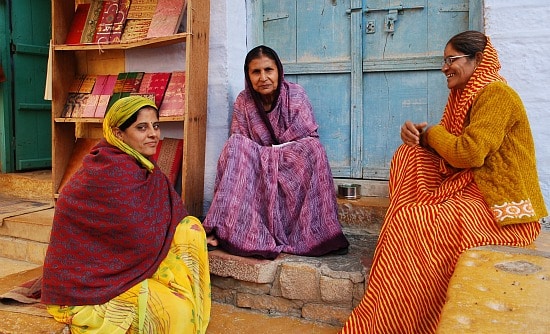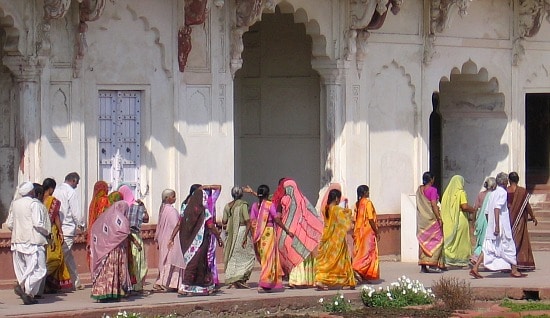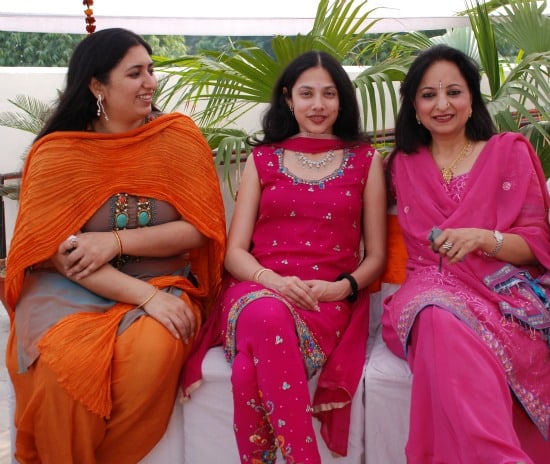When in Rajasthan do as the Rajasthanis do
India is still largely a traditional country, and knowing how to dress can mean the difference between a pleasant journey and many wonderful moments of contact with some of the warmest people on earth — or a sea of hassles.
In spite of what you see in Bollywood movies, most Indians still favour modest, traditional clothing – and you may find that you enjoy your time in India more if you do too. This is especially true once you leave inner city Delhi and Mumbai, or if you go to any social occasions (such as weddings), festivals (such as Diwali or Holi) or to religious gatherings, temples, gurdwaras and mosques. And it’s true in places frequented by lots of tourists.
Though Rajasthan is the Indian state most visited by tourists, it is still one of the most traditional and conservative – and this is amply evident by the way people dress, work and live. Personally, I think it is wise when in Rajasthan to do as the Rajasthanis do. Read on for tips on how to dress for social success in India.
Here’s what you need to know to dress for success
1. Wear “suits”
Bring underwear and comfortable shoes and sandals to India, but not a lot of other clothes. Go shopping in India for three-piece salwar kameez sets (also known as suits). These consist of a long or short tunic, tight or loose pants and a long scarf, called a dupatta or chunni. Wear all three pieces together. Buy cotton in summer and silk or cotton in winter. FabIndia is a great store to buy mix-and-match suits.
2. It pays to fit in
Wearing Indian clothes has several advantages. It suits the climate and the need for modesty, plus you will fit in a bit better, and be less of a target for beggars and touts. You can get in touch with your inner hippie or backpacker in India if you like, but you will pay the price with a lot more hassles. If you are wearing Indian clothes, local people tend to respect you more and also treat you with more warmth, honesty and openness. Try it and see what I mean.
In gurdwaras and mosques you have to cover your head, so it’s a good idea to always have a long scarf (such as a dupatta or chunni) with you.
4. Sensible shoes a must
You need good solid, comfortable shoes in India. The infrastructure is not good so pavement is broken, potholes are everywhere and sewage sometimes runs freely in the streets.
5. Watch your feet
Speaking of shoes, feet and shoes are considered “unclean” in India. You may be asked to remove your shoes to enter people’s homes and you definitely have to leave your shoes at the entrance to temples, gurdwaras and mosques. There is usually someone there who will store them for 10 rupees. Also, never point or touch anything with your foot.
6. Cover up
As a general rule, make sure your legs and shoulders are covered, especially in religious or sacred places. Women in India are very modest about their breasts. They wear armour-like bras and then drape their dupattas over their chests. You will probably not feel comfortable in a thin, light bra; or in clothing that reveals your bra. This look is trendy in the west, but a taboo in India.
7. Splash out on jewelery
The modesty rule goes out the window for jewelry. Layer it on and the bigger the better. But be careful it’s valuable. Don’t wander around displaying valuable rings, watches and other jewelry unless you are in an upscale neighbourhood or at a private social event, hotel or nice restaurant.
8. Pack a shawl
Everyone loves Indian shawls – inaccurately called pashminas – and they can really come in handy for both modesty and warmth. Unless it’s meltingly hot, I usually carry one. Real pashminas, by the way, are very expensive: if someone tries to sell you one for the equivalent of $5, $20, $50 or even $100, guaranteed it’s not pure pashmina.

Mariellen Ward is a freelance travel writer whose personal style is informed by a background in journalism, a dedication to yoga and a passion for sharing the beauty of India’s culture and wisdom with the world. She has traveled for about a year altogether in India and publishes an India travel blog, Breathedreamgo.com. Mariellen also writes for magazines and newspapers.












